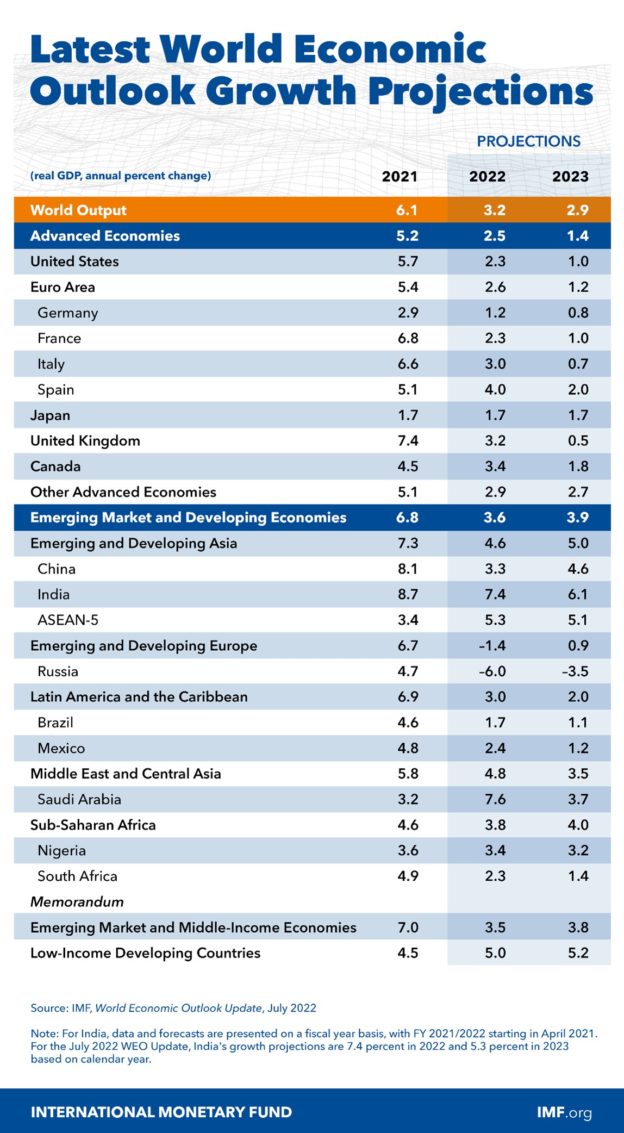China is now projected to grow 3.3% in 2022, the slowest pace in four decades, except for the Covid-induced downturn in 2020.
The International Monetary Fund (IMF) on Tuesday slashed its global growth projections for 2022 and 2023, and warned of a possible worldwide recession next year.
IMF’s forecasts come at a time when the US economy has already shrunk by 1.5% in the March quarter and many fear that growth may have slipped into the negative zone in the June quarter as well. Chances are that the US Federal Reserve rate hikes to check runaway inflation will cause a deeper recession in the world’s largest economy by the end of the year or early next year.
China’s economy is expected to have slowed down in the June quarter from a 4.8% expansion in the previous three months, partly due to Covid-related curbs.
Downside risks from elevated inflation, tight monetary conditions and the Ukraine war are adding to the already “gloomy and more uncertain” global outlook, the IMF said, cautioning that the spike in inflationary pressure, if unchecked, could ultimately trigger recession.
The multilateral body also trimmed its real growth forecasts for India by 80 basis points each for FY23 and FY24 to 7.4% and 6.1%, respectively, from its April projections. “For India, the revision reflects mainly less favourable external conditions and more rapid policy tightening,” the IMF said on Tuesday in its latest update of its World Economic Outlook.
Global real GDP growth will drop to 3.2% in 2022 from 3.6% forecast in April, it said. Global GDP actually shrank in the second quarter of the calendar year 2022 due to downturns in China and Russia. The risks to the outlook are “overwhelmingly tilted to the downside”, it added.
As for 2023, the Fund scaled down its global growth forecast to 2.9% from 3.6% announced in April, as it highlighted the damaging impact of tighter monetary policies across key economies.
“The risk of recession is particularly prominent in 2023, when in several economies growth is expected to bottom out, household savings accumulated during the pandemic will have declined, and even small shocks could cause economies to stall,” the Fund warned. For instance, the US will likely have real GDP growth of only 0.6% in the fourth quarter of 2023 from a year before, which will make it increasingly challenging to avoid a recession.
Global GDP growth hit 6.1% in 2021, having reversed a 3.1% contraction in the previous year in the wake of the pandemic.

“Several shocks have hit a world economy already weakened by the pandemic: higher-than-expected inflation worldwide––especially in the US and major European economies––triggering tighter financial conditions; a worse-than-anticipated slowdown in China, reflecting Covid outbreaks and lockdowns; and further negative spill-overs from the war in Ukraine,” the IMF said.
Worsening prospects in the US, China and the fastest-growing economy, India, drove the IMF’s downward revisions in 2022. It cut its US growth forecast by 1.4 percentage points to 2.3% in 2022, citing a lower-than-anticipated growth in the first half of 2022, dampened household purchasing power and tightening monetary conditions.
The Fund now expects the Chinese economy to grow 1.1 percentage points short of previous estimates, as Beijing adopted extended period of Covid lockdowns and a exacerbating real estate crisis. China is now projected to grow 3.3% in 2022, the slowest pace in four decades, except for the Covid-induced downturn in 2020.
Trade growth projections cut
Given the gloomy economic growth outlook, the Fund also pared down its forecasts of world trade volume growth for 2022 by 90 basis points from its April projection to 4.1%; for 2023, it’s cut by 1.2 percentage points to just 3.2%. This will also weigh on the trade prospects of India, which witnessed an export resurgence in FY22.
Inflation continues to rise
The IMF has now revised up its global inflation forecasts, citing elevated food and energy prices as well as lingering supply-demand imbalances in the wake of the Ukraine war. It now expects inflation to reach 6.6% in advanced economies and 9.5% in emerging market and developing economies this year—upward revisions of 0.9 and 0.8 percentage point, respectively. In 2023, disinflationary monetary policy is expected to bite, with global output growing by just 2.9 percent.
Taming inflation priority
The Fund said tighter monetary policy will inevitably have real economic costs, but delay will only exacerbate them. “Targeted fiscal support can help cushion the impact on the most vulnerable, but with government budgets stretched by the pandemic and the need for a disinflationary overall macroeconomic policy stance, such policies will need to be offset by increased taxes or lower government spending,” the multilateral body said.
https://www.financialexpress.com/economy/imf-slashes-global-growth-forecasts/2607398/





